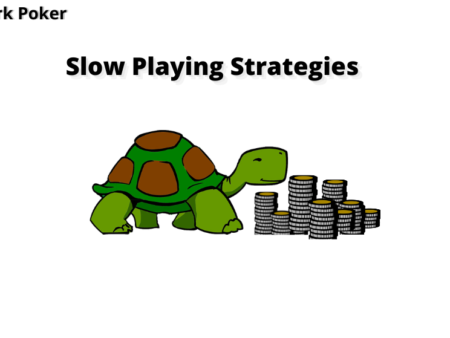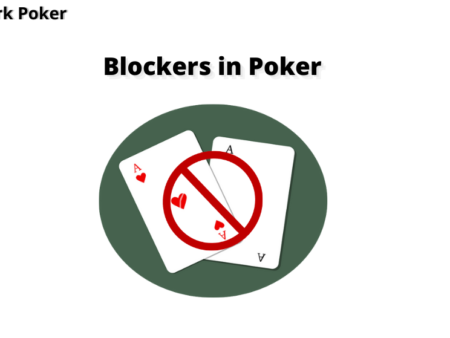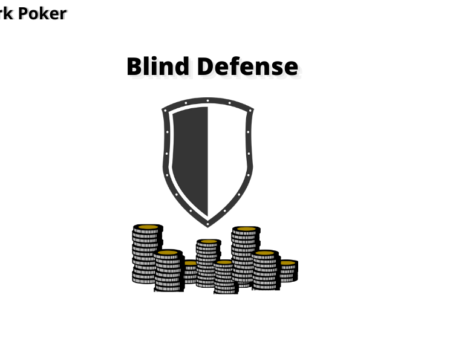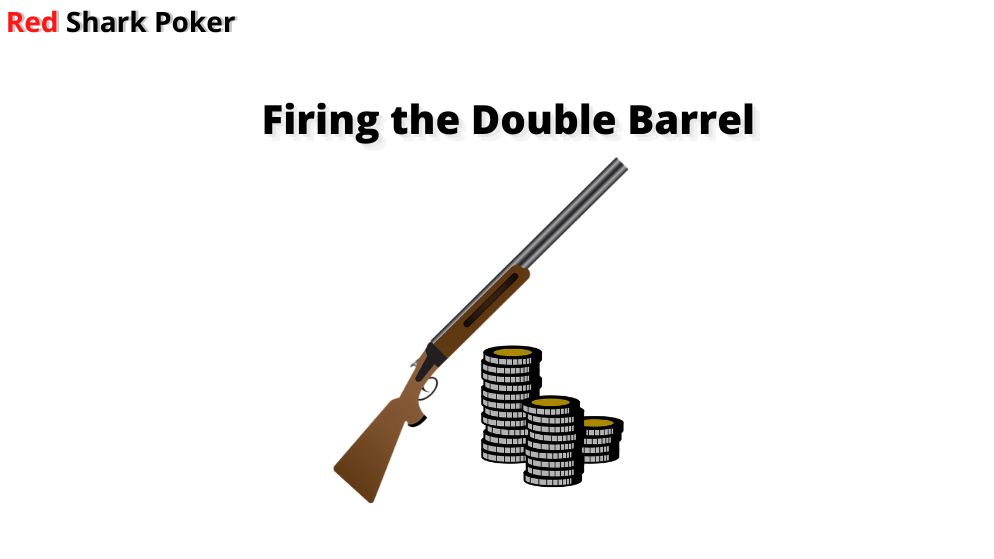
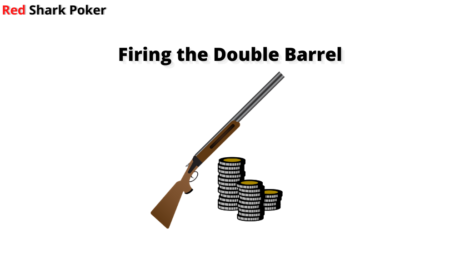
Let’s understand the concept of double barrel in poker with an example. You raise to 3X big blind with A♠ K♠ from middle position. The button calls, and others fold. The flop reads 10♦ 7♥ 3♣. You didn’t connect on the flop but don’t worry, as you are most likely to miss 2/3 times on the flop. You decide to cbet, and your opponent calls. The turn reads 10♦ 7♥ 3♣ Q♠. You have missed on the turn again. What will you do now? Will you bet again on the turn, which is also known as “firing the double barrel”?
The act of betting on the turn after cbetting on the flop is called double barrelling. So, let’s learn about this tricky art of firing the double barrel in poker. Continue reading this chapter to when and when not to fire the double barrel.
What is a Double Barrel in Poker?
Double barrelling can be described as continuing your cbet on the turn. If you make a cbet on the flop and make a bet on the turn, it will be called a double barrel. Double barrelling is mostly used when you bluff or semi-bluff on the turn after you have missed connecting both on the flop and the turn. The intent of double barrelling in poker is to make your opponent fold on the turn. You are not trying to build the pot but trying to win the pot with a bluff.
In the above example, if you raised with A♠ K♠ and made a bet on a 10♦ 7♥ 3♣ flop, you have made a cbet on a missed flop. If you bet again on a 10♦ 7♥ 3♣ Q♠ turn, you are bluffing again on a missed turn. This is called firing a double barrel. If your opponent folds here, you have successfully fired a double barrel in poker.
Make the Right Cbet Before Double Barrelling
Always remember that a double barrel is fired after you have made a cbet. So, cbet lays the foundation for double barrelling in poker. A lot of players fail at double barrelling due to bad cbet sizing on the flop. A bad cbet size leads to a bad double barrel. Most of the beginners have the habit of betting the same preflop bet size on the flop. For example, if you have raised 5X big blind (bb) on the preflop, don’t cbet the same 5X bb on the flop. Any post-flop bet size should always be in relation to the current pot size. So, a good cbet size should be 2/3 of the pot or 3/4 of the pot or a full pot bet. Also, don’t cbet if it goes multiway, especially with calling stations.
If you want to know more about how to make the perfect cbet, read this chapter: How to Make the Right Cbet?
When to Double Barrel in Poker
Double barrelling is basically making a bluff or a semi-bluff. So, it is important to consider the following factors before you double barrel in poker.
Fire the Double Barrel with Some Equity
It is always better to have some equity in your hand before double barrelling. If a novice player who cannot comprehend what you are representing calls your double barrel, you can still be saved if you have some equity. If one of your available outs hits on the river, you have the chance to win a big pot. Let’s look at three situations with the same turn and different hands.
Hand #1: A♠ K♠
Turn: 10♦ 7♥ 3♣ Q♠
You have 6 outs that can make a top pair on the river and 4 outs that can complete a gutshot straight draw. This gives you a total of 10 outs (21.7% equity).
Hand #2: A♠ 5♠
Turn: 10♦ 7♥ 3♣ Q♠
You have 3 outs that can make a top pair on the river. This gives you 6.5% equity.
Hand #3: 2♠ 2♣
Turn: 10♦ 7♥ 3♣ Q♠
You have only 2 outs that can help you to make a set on the river. This gives you 4.4% equity.
So, the first situation puts you in a better position to double barrel as you have more outs that can hit the board on the river.
Check: Poker Outs and Equity Chart
Double Barrel When a Scare Card Hits on Turn
A scare card is referred to a card that falls in your perceived range. For example, broadway cards like Aces, Kings or Queens easily fall in the range of a preflop raiser, especially when raised from an early position. If such a card hits on the turn, it can scare your opponents. So, when a scare card hits on the turn, it is easier to represent a top pair and scare your opponent with a double barrel.
Good Cards on the Turn to Double Barrel
An overcard on the turn is the best card for you to double barrel. However, it is better to double barrel on a dry board. Double barrelling on a wet board might prove to be costly if your opponent has draws and calls your bet.
Some board texture examples that help you to double barrel in poker are as follows:
Dry Flop with a Broadway Card + Overcard on the Turn
Flop: K♣ 7♥ 3♦ | Turn: A♠
Flop: Q♥ 9♣ 5♠ | Turn: K♦
Flop: J♣ 7♦ 2♥ | Turn: Q♠
If there is a broadway (A, K, Q & J) on a dry flop, it is the best flop to make a bluff cbet. A broadway card is well within your range as a preflop raiser. However, if your opponent called on a dry flop, it could mean two things:
- Your opponent called with the top pair (broadway)
- Your opponent called with a middle pair.
Things change when an overcard hits on the turn. This overcard falls well within your perceived range. This works in two ways:
1) If your opponent called with the top pair (broadway) on the flop, an overcard on the turn will scare him.
2) If your opponent called with the middle pair on the flop, your representation of the top pair on the flop becomes even stronger. Also, the overcard adds more fear.
Overall, the overcards on the turn help you to continue your story as a preflop raiser, and you can comfortably double barrel to force your opponent to fold.
Dry Flop with No Broadway + Broadway on the Turn
Flop: 10♣ 5♥ 3♦ | Turn: K♠
Flop: 2♥ 9♣ 5♠ | Turn: Q♦
Flop: 8♣ 5♦ 2♥ | Turn: J♠
When your opponent called your cbet on a dry flop with no broadway cards, you can comfortably double barrel when a broadway card hits on the turn. This helps you to bluff even better as the high card (broadway) is well within your range. Your opponent will most likely fold to your double barrel as the representation of your top pair beats their middle or bottom pair.
Read: Detailed Chapter on How to Bluff in Poker
When Not to Double Barrel in Poker
Any card on the turn that doesn’t help to represent your range as a preflop raiser is a bad situation for double barrelling in poker. Let’s look at some of the turns where you shouldn’t double barrel.
Low Cards on the Turn
Flop: J♣ 5♥ 7♦ | Turn: 2♠
Flop: Q♥ 9♣ 5♠ | Turn: 4♦
Low cards or undercards on the turn are really bad cards for you to double barrel. They do not help you to continue your story as a preflop raiser. These low or undercards are not within your range, and your opponent will most likely call as the turn hasn’t improved your hand.
Paired Board
Flop: J♣ 5♥ 7♦ | Turn: J♠
Flop: Q♥ 9♣ 5♠ | Turn: 9♦
If the card on the turn pairs with any card on the board, it is better not to double barrel. Your opponent might hit a trips, and he can start setting up a trap. Also, if your opponent already has a pair, he will be having two pairs on the turn. It will be very difficult for your opponent to fold a two pair. So, it is better to check or fold if you face a bet.
What Should be the Bet Size of Your Double Barrel?
Your bet size represents the strength of your hand. Since you are bluffing on the turn, your bet size should not represent any kind of weakness. So, the bet size should be bigger than your cbet size. When you start with your preflop raise, you are already representing a strong starting hand. A cbet of 2/3 of the pot to a full pot size represents a stronger hand on the flop. So, your double barrel bet size should definitely be bigger than your cbet size to indicate that you have a strong hand.
Preflop Raise Size < Cbet Size < Double Barrel Bet Size
If you have made a cbet of 2/3 of the pot on the flop, you should double barrel with a 3/4 of a pot-size bet. Similarly, if you have made a cbet of 3/4 of the pot, you should double barrel with a full pot size bet. If you reduce it to a 1/4 pot-size bet, it shows weakness, and your opponent will end up calling. Also, you will end up giving good pot odds to your opponent if he has draws.
Know Your Opponent Before You Double Barrel in Poker
The most important consideration before making any kind of bluff is to know your opponent well. You must have some history of playing with your opponent to know how often he folds to a double barrel. HUD software helps a lot in such situations as you can track Fold to Double Barrel percentage of your opponents. If you are not using one, make sure to identify the type of opponent you are up against.
Against a Loose-Passive Player (Fish)
Loose passive players have the tendency to keep calling to see the next card. Things get worse if you are up against a sticky fish who never folds if they get a piece of the board. So, it is not recommended to double barrel against fish, especially if he is a sticky fish. It is better to check as your bluff won’t work against loose-passive players.
Against a Tight-Aggressive Player (TAG)
It is relatively easier to double barrel and bluff against a TAG. They are mostly mathematical players who will fold if you give tough pot odds with a big bet. Things get better if you are up against a super tight player (NIT) who won’t risk a large portion of their stack if they don’t have the nuts.
Conclusion
As you have already made a cbet and invested a lot in the pot, double barrelling is a good move to steal the pot when you don’t connect on the turn. However, you should analyse the board texture and the type of opponent before double barrelling in poker. Also, you shouldn’t double barrel all the time as you may lose credibility. So, find a good balance in your double barrelling frequency before opting to fire the second barrel.
Read the next chapter: How to Fire the Triple Barrel in Poker?

